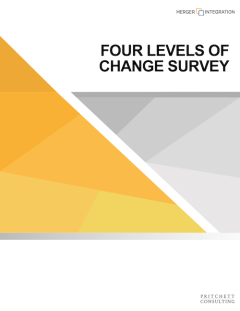
Level 1
Cope with Change
A culture is operating at the first level of change when people primarily think in terms of just coping with the situation. They respond to change with a “victim mentality.” You see a lot of helplessness and dependency behavior. The general outlook is pessimistic. Too much valuable energy gets invested in resistance, anger, blamefulness, or fear. People focus on problems instead of solutions. They talk about how hard things are, and why they can’t make it work. Usually the mindset at level one is that maybe change will pass. People wait and hope for a so-called “return to normal.”
When a culture is stuck in the coping mode, people tend to slow down. They’re overly cautious, too conservative, and it causes an organization to lose momentum. Naturally, productivity drops. Operating results take a hit. Employee energy and attention get diverted away from basic company business, and toward “me issues”—that is, concern over how one might be affected personally by the change.
When a culture lives at the first level of change, people try to protect the status quo. This means they make little effort to innovate, experiment, or take reasonable and appropriate risks. They hang on to the past instead of actively seeking to shape a better future. In the competitive game of business, they rely on defense and are lousy at playing offense.
Overall, level one cultures are reactive, not proactive. It’s the sort of culture that undermines both our individual and organizational effectiveness.
Level 2
Comply with change
Cultures operating at the second level of change display more of an “adjustment mentality.” Here at level two there’s a clear, but not impressive, effort made to comply with the situation. Folks may not like what’s going on one bit, yet they spend some energy accommodating the change. It may only be grudging compliance, or sort of a “cut your losses” attitude. Could be they’re merely accepting the inevitable. But people here basically go with the flow.
Nevertheless, these cultures are dangerously sluggish. The main problem, of course, is that people in level two fail to put forth the personal effort they should to help drive the change. They may have resigned themselves to what’s going on, but they don’t do all they should to bring about success. People go along but may grumble, and they fail to function as effective change agents.
Cultures operating at level two fall way short of realizing their full potential. They’re followers, not leaders, and have difficulty trying to compete.
Level 3
Capitalize on Change ...
